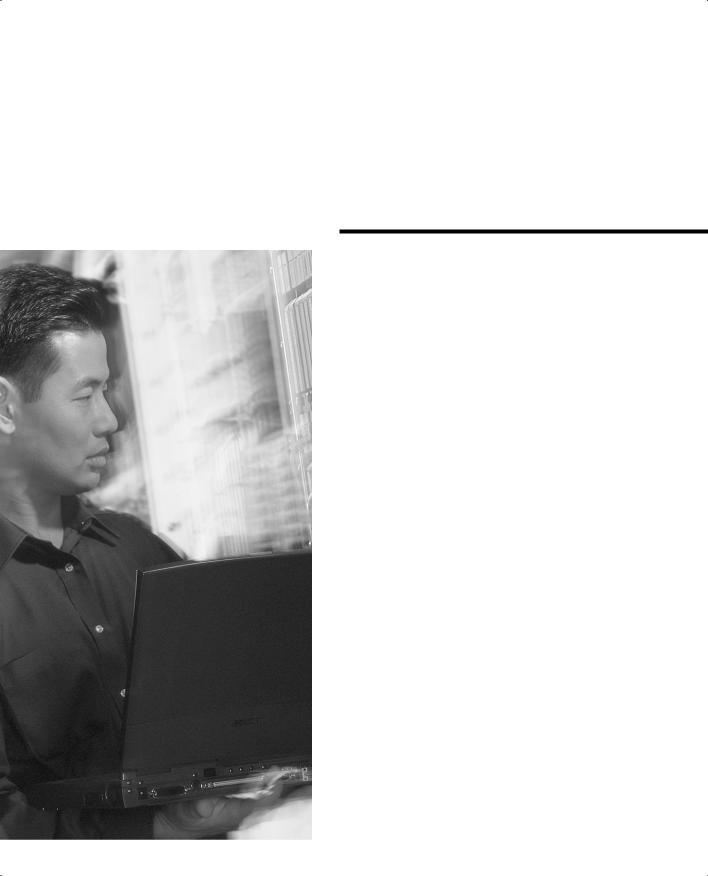
CCNP 642-811 BCMSN Exam Certification Guide - Cisco press
.pdf
276 Chapter 11: Protecting the Spanning Tree Protocol Topology
Q&A
The questions and scenarios in this book are more difficult than what you should experience on the actual exam. The questions do not attempt to cover more breadth or depth than the exam; however, they are designed to make sure that you know the answers. Rather than allowing you to derive the answers from clues hidden inside the questions themselves, the questions challenge your understanding and recall of the subject. Hopefully, these questions will help limit the number of exam questions on which you narrow your choices to two options and then guess.
The answers to these questions can be found in Appendix A.
1.Why would a unidirectional link be bad?
2.What condition must be met to keep a switch port in the blocking state?
3.If a switch port is shown to be in the root-inconsistent state, what has happened on it?
4.When root guard has been triggered on a switch port, what must be done to enable the port for use again?
5.When BPDU guard is enabled on a switch port, what state will the port be put in if a BPDU is received on it?
6.When BPDU guard has been triggered on a switch port, what must be done to enable the port for use again?
7.What can happen if BPDUs are delayed or “skewed” as they pass along from switch to switch?
8.What action does BPDU skew detection take when late BPDUs are detected?
9.When loop guard is enabled on a switch port and what state will the port be put in if BPDUs are noted to be missing?
10.Can STP loop guard be enabled on all switch ports?
11.When UDLD is enabled on a switch port, what else must be done to detect a unidirectional link on the port?
12.What is the difference between the UDLD normal and aggressive modes?
13.What command enables UDLD aggressive mode on a switch interface?

Q&A 277
14.If two switches enable UDLD on the ports that have a common link, do their UDLD message times have to agree?
15.UDLD should be used on switch ports with what type of media?
16.Can UDLD be used on all switch ports without causing problems?
17.Complete the following command to display all ports that are disabled due to STP protection features:
show spanning-tree

This chapter covers the following topics that you need to master for the CCNP BCMSN exam:
■Rapid Spanning Tree Protocol (RSTP)—
This section discusses the enhancements that allow switches to run STP efficiently, offering fast convergence.
■Multiple Spanning Tree (MST) Protocol—
This section discusses the latest IEEE standard that supports a reduced number of STP instances for a campus network, while using RSTP for efficient operation.

C H A P T E R 12
Advanced Spanning Tree
Protocol
Familiarity with the IEEE 802.1D STP standard is essential because that protocol is used universally to maintain loop-free bridged and switched networks. However, it is now considered a legacy protocol, offering topology change and convergence times that are not as acceptable as they once were.
This chapter discusses the many STP enhancements that are available in new standards. The Rapid STP (RSTP) is presented first because it provides the foundation for efficient STP activity. The Multiple STP (MST or MSTP) is also discussed here. MST allows VLANs to be individually mapped into STP instances, while RSTP operates in the background. These two protocols allow a Layer 2 campus network to undergo change quickly and efficiently, with little downtime for today’s applications.
“Do I Know This Already?” Quiz
The purpose of the “Do I Know This Already?” quiz is to help you decide if you need to read the entire chapter. If you already intend to read the entire chapter, you do not necessarily need to answer these questions now.
The quiz, derived from the major sections in the “Foundation Topics” portion of the chapter, helps you determine how to spend your limited study time.
Table 12-1 outlines the major topics discussed in this chapter and the “Do I Know This Already?” quiz questions that correspond to those topics.
Table 12-1 “Do I Know This Already?” Foundation Topics Section-to-Question Mapping
Foundation Topics Section |
Questions Covered in This Section |
|
|
Rapid STP |
1–8 |
|
|
Multiple STP (MST) |
9–12 |
|
|

280 Chapter 12: Advanced Spanning Tree Protocol
CAUTION The goal of self-assessment is to gauge your mastery of the topics in this chapter. If you do not know the answer to a question or are only partially sure of the answer, you should mark this question wrong. Giving yourself credit for an answer you correctly guess skews your selfassessment results and might give you a false sense of security.
1.Which one of the following enables the use of RSTP?
a.PVST+
b.802.1D
c.CST
d.MST
2.Upon which standard is RSTP based?
a.802.1Q
b.802.1D
c.802.1w
d.802.1s
3.Which of the following is not a port state in RSTP?
a.Listening
b.Learning
c.Discarding
d.Forwarding
4.When a switch running RSTP receives an 802.1D BPDU, what happens?
a.The BPDU is discarded or dropped.
b.An ICMP message is returned.
c.The switch begins to use 802.1D rules on that port.
d.The switch disables RSTP.

“Do I Know This Already?” Quiz 281
5.When does an RSTP switch consider a neighbor to be down?
a.After three BPDUs are missed
b.After six BPDUs are missed
c.After the Max Age timer expires
d.After the Forward Timer expires
6.Which process is used during RSTP convergence?
a.BPDU propagation
b.Synchronization
c.Forward Timer expiration
d.BPDU acknowledgments
7.What causes RSTP to view a port as a point-to-point port?
a.Port speed
b.Port media
c.Port duplex
d.Port priority
8.Which of the following events triggers a topology change with RSTP on a nonedge port?
a.A port comes up or goes down.
b.A port comes up.
c.A port goes down.
d.A port moves to the forwarding state.
9.Which of the following is not a characteristic of MST?
a.A reduced number of STP instances
b.Fast STP convergence
c.Eliminates the need for CST
d.Interoperability with PVST+

282Chapter 12: Advanced Spanning Tree Protocol
10.Which of the following standards defines the MST protocol?
a.802.1Q
b.802.1D
c.802.1w
d.802.1s
11.How many instances of STP are supported in the Cisco implementation of MST?
a.1
b.16
c.256
d.4096
12.What switch command can be used to change from PVST+ to MST?
a.spanning-tree mst enable
b.no spanning-tree pvst+
c.spanning-tree mode mst
d.spanning-tree mst
You can find the answers to the “Do I Know This Already?” quiz in Appendix A, “Answers to Chapter ‘Do I Know This Already?’ Quizzes and Q&A Sections.” The suggested choices for your next step are as follows:
■10 or less overall score—Read the entire chapter. This includes the “Foundation Topics,” “Foundation Summary,” and “Q&A” sections.
■11 or 12 overall score—If you want more review on these topics, skip to the “Foundation Summary” section and then go to the “Q&A” section at the end of the chapter. Otherwise, move to Chapter 13, “Multilayer Switching.”

Rapid Spanning Tree Protocol (RSTP) 283
Foundation Topics
Rapid Spanning Tree Protocol (RSTP)
The IEEE 802.1D Spanning Tree Protocol was designed to keep a switched or bridged network loop free, with adjustments made to the network topology dynamically. A topology change typically takes 30 seconds, where a port moves from the Blocking state to the Forwarding state after two intervals of the Forward Delay timer. As technology has improved, 30 seconds has become an unbearable length of time to wait for a production network to failover or “heal” itself during a problem.
The IEEE 802.1w standard was developed to take 802.1D’s principle concepts and make the resulting convergence much faster. This is also known as the Rapid Spanning Tree Protocol (RSTP). RSTP defines how switches must interact with each other to keep the network topology loop free, in a very efficient manner. Like 802.1D, RSTP’s basic functionality can be applied as a single or multiple instances. This can be done as the IEEE 802.1s Multiple Spanning Tree (MST), covered in this chapter, and also as the Cisco-proprietary, Rapid Per-VLAN Spanning Tree Protocol (RPVST+). RSTP operates consistently in each, but replicating RSTP as multiple instances requires different approaches.
RSTP Port Behavior
In 802.1D, each switch port is assigned a role and a state at any given time. Depending on the port’s proximity to the Root Bridge, it takes on one of the following roles:
■Root Port
■Designated Port
■Blocking Port (neither Root nor Designated).
The Cisco-proprietary UplinkFast feature also reserved a hidden Alternate Port role for ports that offered parallel paths to the Root but were in the Blocking state.
Recall that each switch port is also assigned one of five possible states:
■Disabled
■Blocking
■Listening
■Learning
■Forwarding


Rapid Spanning Tree Protocol (RSTP) 285
RSTP uses the 802.1D BPDU format for backward-compatibility. However, some previously unused bits in the Message Type field are used. The sending switch port identifies itself by its RSTP role and state. The BPDU version is also set to 2, to distinguish RSTP BPDUs from 802.1D BPDUs. Also, RSTP uses an interactive process so that two neighboring switches can negotiate state changes. Some BPDU bits are used to flag messages during this negotiation.
BPDUs are sent out every switch port at Hello Time intervals, regardless of whether BPDUs are received from the Root. In this way, any switch anywhere in the network can play an active role in maintaining the topology. Switches can also expect to receive regular BPDUs from their neighbors. When three BPDUs are missed in a row, that neighbor is presumed to be down, and all information related to the port leading to the neighbor is immediately aged out. This means that a switch can detect a neighbor failure in three Hello intervals (default 6 seconds), versus the Max Age Timer interval (default 20 seconds) for 802.1D.
Because RSTP distinguishes its BPDUs from 802.1D BPDUs, it can coexist with switches still using 802.1D. Each port attempts to operate according to the STP BPDU that is received. For example, when an 802.1D BPDU (version 0) is received on a port, that port begins to operate according to the 802.1D rules. However, each port has a measure that locks the protocol in use for the duration of the migration delay timer. This keeps the protocol type from flapping or toggling during a protocol migration. After the timer expires, the port is free to change protocols if needed.
RSTP Convergence
The convergence of STP in a network is the process that takes all switches from a state of independence (each thinks it must be the STP Root) to one of uniformity, where each switch has a place in a loop-free tree topology. You can think of convergence as a two-stage process:
1.One common Root Bridge must be “elected,” and all switches must know about it.
2.The state of every switch port in the STP domain must be brought from a Blocking state to the appropriate state to prevent loops.
Convergence generally takes time, as messages are propagated from switch to switch. The traditional 802.1D STP also requires the expiration of several timers before switch ports can be safely allowed to forward data.
RSTP takes a different approach when a switch needs to decide how to participate in the tree topology. When a switch first joins the topology (perhaps it was just powered up) or has detected a failure in the existing topology, RSTP requires it to base its forwarding decisions on the type of port.
